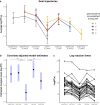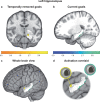The hippocampus dissociates present from past and future goals
- PMID: 38844456
- PMCID: PMC11156658
- DOI: 10.1038/s41467-024-48648-9
The hippocampus dissociates present from past and future goals
Abstract
Our brain adeptly navigates goals across time frames, distinguishing between urgent needs and those of the past or future. The hippocampus is a region known for supporting mental time travel and organizing information along its longitudinal axis, transitioning from detailed posterior representations to generalized anterior ones. This study investigates the role of the hippocampus in distinguishing goals over time: whether the hippocampus encodes time regardless of detail or abstraction, and whether the hippocampus preferentially activates its anterior region for temporally distant goals (past and future) and its posterior region for immediate goals. We use a space-themed experiment with 7T functional MRI on 31 participants to examine how the hippocampus encodes the temporal distance of goals. During a simulated Mars mission, we find that the hippocampus tracks goals solely by temporal proximity. We show that past and future goals activate the left anterior hippocampus, while current goals engage the left posterior hippocampus. This suggests that the hippocampus maps goals using timestamps, extending its long axis system to include temporal goal organization.
© 2024. The Author(s).
Conflict of interest statement
The authors declare no competing interests.
Figures



Update of
-
Hippocampal timestamp for goals.bioRxiv [Preprint]. 2023 Jul 28:2023.07.27.550892. doi: 10.1101/2023.07.27.550892. bioRxiv. 2023. Update in: Nat Commun. 2024 Jun 6;15(1):4815. doi: 10.1038/s41467-024-48648-9. PMID: 37546946 Free PMC article. Updated. Preprint.
References
-
- Robin J, Moscovitch M. Details, gist and schema: hippocampal–neocortical interactions underlying recent and remote episodic and spatial memory. Curr. Opin. Behav. Sci. 2017;17:114–123. doi: 10.1016/j.cobeha.2017.07.016. - DOI
MeSH terms
Grants and funding
LinkOut - more resources
Full Text Sources
Medical
Miscellaneous

